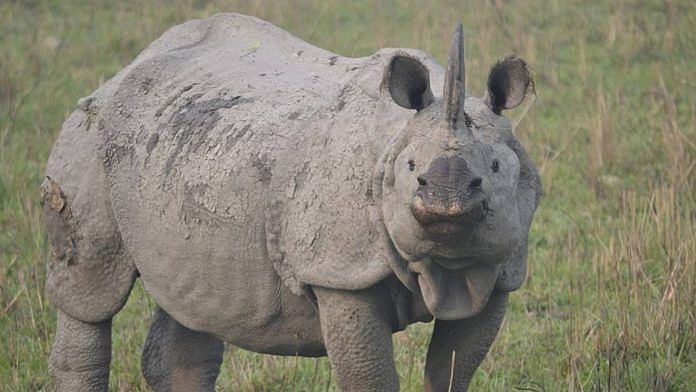New Delhi: In a bid to send a strong message against poaching, Assam will publicly destroy approximately 2,479 rhino horns, recovered and preserved by the government for the past four decades, at Bokahat Stadium ground in the state’s Golaghat district Wednesday.
The destruction of the horns — they will be consigned to flames — has been planned by the state to celebrate World Rhino Day, on 22 September.
A statement issued by Assam Environment Minister Parimal Suklabaidya Tuesday stated: “This is the largest public destruction of the stockpile of horns of the Greater One-Horned rhino and is aimed to propagate and reinforce the fact that rhinos horns do not have any medicinal value.”
Of the 2,623 rhino horns reconciled (an official term for recovered or collected) by Assam’s forest department between 1979 and 2021, 2,479 will be destroyed while 94 will be preserved for academic purposes at the Kaziranga National Park and 29 are associated with court cases. The remaining 21 are said to be fake horns.
The horns had been recovered from poachers or collected from dead rhinos in the state’s national parks, and kept under the custody of the forest department or treasuries in various districts. They were reconciled by a committee headed by the Chief Wildlife Warden, following the Assam cabinet’s decision last week to destroy the horns.
There is a standing Supreme Court instruction to burn recovered wild animal body parts like elephant tusks and rhino horns. While Assam had disposed of horns recovered before 1979, those collected since have been reportedly preserved because of the locals’ emotional attachment to them.
Many wildlife experts applauded Assam’s decision to burn the horns, as proof of the country’s efforts in conserving endangered species.
Despite the international ban on the trade of rhino horn by the Convention on International Trade in Endangered Species of Fauna and Flora (CITES) since 1977, China in 2018 publicly announced its intentions to legalise domestic rhino horn trade, which had already led to a spike in poaching over the past decade. China considers rhino horns to be an essential ingredient in traditional Chinese medicine.
According to a report by Save The Rhino — Europe’s largest single-species rhino charity — however, the highest number of poaching incidents are reported from South Africa, with the country recording 394 such cases in 2020 alone.
In India, one-horned rhinos were declared endangered in 1975, but were downgraded to ‘vulnerable’ in the 2008 Red list of the International Union for Conservation of Nature.
Also read: From bare hills to thriving home for Asiatic Lion — how Girnar scripted a green makeover
‘Poachers don’t care about medicinal value’
Assam minister Suklabaidya last month said that poachers have killed 22 one-horned rhinos in the state since 2017 and that till June this year, 644 poachers have been arrested for the same.
He also mentioned that his government has installed 10 fast-track sessions courts for speedy trials of wildlife-related crimes.
Speaking to ThePrint over phone, Dr Yadvendradev Jhala, dean of the Wildlife Institute of India in Uttarakhand said, “It’s a wonderful initiative (the burning of horns) showcasing India’s effort and commitment towards conservation of endangered species and to convey to the world that we do not advocate such practices.”
He added: “Although it’s an illegal market, it is still out there. Poachers, who risk their lives to trade these rhino horns, don’t care if it has medicinal values. They do so because a rhino horn is worth crores in markets in China and some other Southeast Asian countries.”
In April this year, Assam successfully increased its rhino population to 3,000 as targeted under Indian Rhino Vision 2020 after the eighth round of rhino translocation on 13 April. They were spread across three protected areas namely, Kaziranga National Park, Orang National Park and Pobitora Wildlife Sanctuary. The state had about 2,000 rhinos in 2005 before the IRV2020 project.
The Indian Rhino Vision (IRV) 2020 programme is an initiative led by the Forest Department of Assam, World WildLife India, and International Rhino Foundation to help India re-introduce rhinos to one of its historical range areas, particularly Assam’s Manas National Park, the first Protected Area (PA) under the IRV2020 programme.
According to a report by Save The Rhino, the number of the Greater One-Horned rhinos, also known as Rhinoceros unicornis, in Asia dwindled to less than 200 in the early 1900s due to hunting and habitat loss. Due to the strict restrictions placed by the Indian and Nepal governments, the population of the species rose to around 2,500 by 2005.
However, the report stated that the comeback of the one-horned rhinos to India and particularly to Assam —where more than 90 per cent of these rhinos are found — is met with a lack of adequate habitat, with the species now found in only the three protected areas in the state.
Also read: Only 10 wild buffaloes left, Chhattisgarh looks at surrogacy to boost state animal’s numbers



